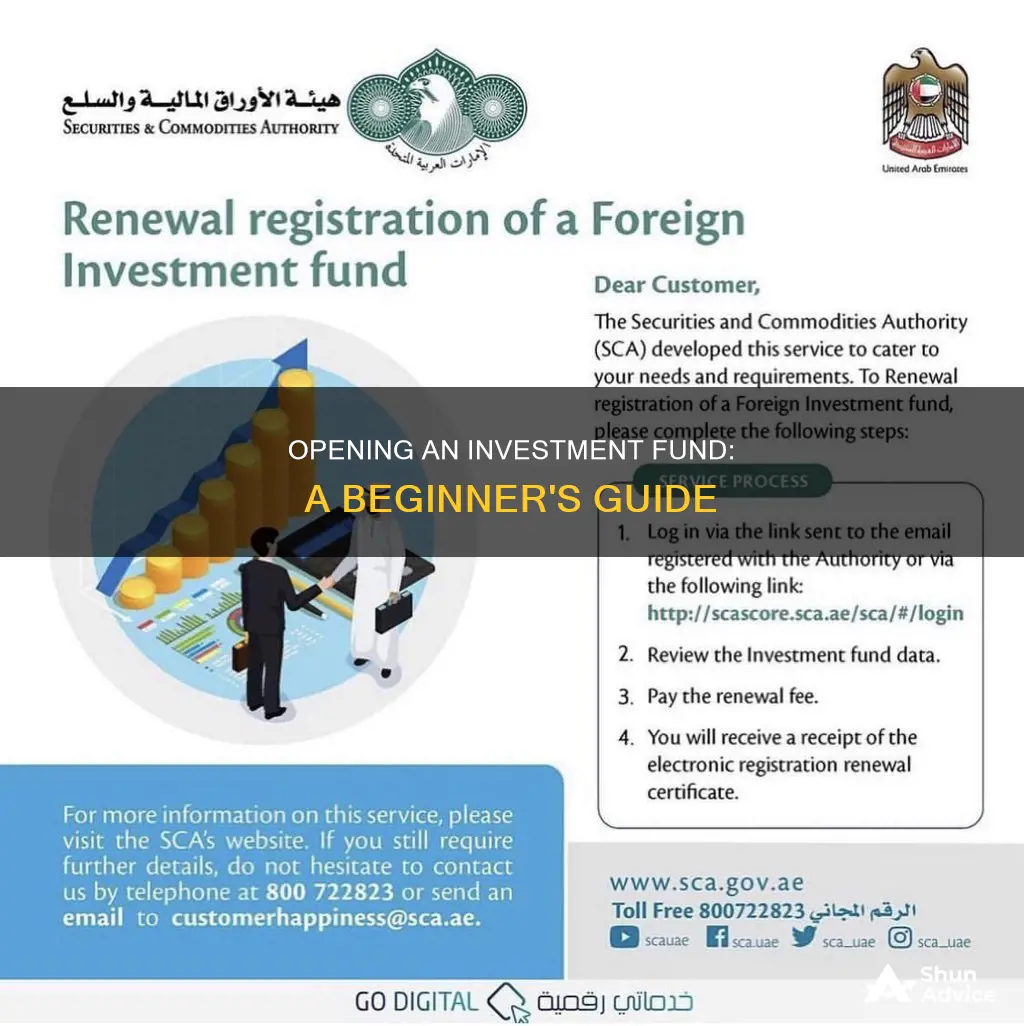
Setting up an investment fund is a complex process that requires careful planning and consideration. It is important to understand the different types of investment companies, such as closed-end and open-end investment companies, and choose the appropriate business structure, such as a corporation, partnership, or limited liability company (LLC). Seeking legal advice and registering with the relevant government agencies are crucial steps in the process. Additionally, developing a comprehensive business plan and marketing strategy is essential for success. While starting an investment fund can be challenging, it is a viable option for those with the necessary expertise and resources.
| Characteristics | Values |
|---|---|
| Type of investment company | Closed-end or open-end |
| Business structure | Corporation, partnership, or limited liability company (LLC) |
| Business name | Should stand out, connect to your values and investing strategy, and not already be chosen or trademarked in your jurisdiction |
| Investment strategy | Clear, replicable, and scalable |
| Operating document | Bylaws, partnership agreement, or operating agreement |
| Licenses | Series 65 license in the U.S. |
| Registration | With state and federal government in the U.S. |
| Trading account | E*Trade, Charles Schwab, or similar |
| Tax IDs | Federal Employer Identification Number (FEIN) and state/local tax registration in the U.S. |
| Target client | Sophisticated or novice investors, established professionals or millennials |
| Branding | Logo and tagline that convey your brand |
| Website | Includes background of employees, fund performance, and articles explaining investment concepts |
What You'll Learn

Define your investment strategy
When defining your investment strategy, it's important to remember that there is no one-size-fits-all approach. Your strategy will depend on your personal circumstances, including your age, capital, risk tolerance, and financial goals. Here are some key considerations to help you define your investment strategy:
- Risk and return: Risk and return are two important factors to consider when defining your investment strategy. Most investors accept a certain level of risk in exchange for the potential of higher returns. It's crucial to understand your own risk tolerance and make investment choices that align with your comfort level.
- Time horizon: The time frame of your investments will influence your strategy. For example, stocks are typically recommended for a minimum time horizon of five years. It's also recommended to have six to twelve months' worth of expenses in an easily accessible account before investing in riskier options.
- Active vs. passive strategies: Passive strategies, such as buy-and-hold and passive indexing, aim to minimise transaction costs. Passive investors believe that timing the market is impossible. On the other hand, active strategies, like momentum trading, aim to outperform benchmark indexes, and active investors believe they have above-average skills.
- Investment choices: There are various investment choices available, including stocks, bonds, mutual funds, and exchange-traded funds (ETFs). Stocks, or equities, represent ownership in a company and are purchased at a share price. Bonds are loans to a company or government entity, offering a fixed repayment period and interest rate. Mutual funds and ETFs are collections of various investments, providing instant diversification.
- Types of investment strategies: Common investment strategies include momentum trading, where investments are selected based on their recent performance; buy-and-hold, where investments are held for a long period despite market volatility; long-short strategy, which involves ranking equities based on an alpha factor and making corresponding long and short positions; and indexing, where an investor buys a small proportion of all shares in a market index or an index mutual fund/ETF.
- Other factors: Other factors to consider include the stage of market development (developed vs. emerging), dividend growth potential, dollar-cost averaging to reduce the risk of substantial losses, and contrarian investment, which involves investing in strong companies during market downturns.
Cash Reserves Fund: A Safe and Smart Investment Choice
You may want to see also

Choose a business structure
The business structure you choose for your investment fund will depend on several factors, including the level of liability protection, the tax implications, and the level of flexibility you require. Here are some common business structures to consider:
- Sole Proprietorship: This is the simplest and usually the least costly business structure to set up. In a sole proprietorship, the owner of the investment company and the business are the same legal person. The owner is solely responsible for all debts and obligations of the business. However, it offers no protection against damages incurred during business operations, and the owner becomes personally liable for all damages. Sole proprietorships are typically not suitable for attracting outside private investment.
- Partnership: A partnership is an agreement between two or more people who want to start an investment company together. Partners share profits and losses, and it is easy to set up. However, partners are jointly liable for business debts, and disagreements can be challenging to resolve. Some jurisdictions allow for limited partnerships, where only the general partner is personally liable for obligations.
- Limited Liability Company (LLC): An limited liability company (LLC) provides limited liability protection to its owners, meaning they are not personally responsible for the company's debts and liabilities. LLCs offer flexibility in management and avoid double taxation. However, they may not be available in some states, and members may face self-employment taxes. LLCs are generally not suitable for attracting outside private investment.
- C Corporation: A C corporation is a separate legal entity from its owners, with its own tax ID and the ability to have shareholders. It offers limited liability protection to its owners, but it is subject to double taxation, where both the corporation and shareholders pay taxes on profits.
- S Corporation: An S corporation is a type of corporation that provides limited liability protection and allows for pass-through taxation, avoiding double taxation. However, there are restrictions on the number and type of shareholders, and they can only issue one type of stock. S-corporations are generally not attractive to outside private investors.
When choosing a business structure, it is essential to consider the legal and tax implications, as well as the level of liability protection and flexibility you require. Consult with an attorney or legal advisor to determine the best business structure for your investment fund.
Strategies for Investing in Ray Dalio's Principles Fund
You may want to see also

Hire a lawyer
Lawyers are an essential part of the team when setting up an investment fund. The legal structure of the fund is critical, and the right legal advice can ensure the fund is established correctly and runs smoothly.
In the US and Europe, most funds are structured as either limited partnerships or limited liability firms. The former is the more common option, as it is viewed as more legitimate and less "shady" than the latter. As the founder of the fund, you will be a general partner, meaning you have the right to decide on the fund's investments. Investors will be limited partners, who do not have the same decision-making rights and are only accountable for losses tied to their individual investments.
Your lawyer will be responsible for drafting a range of documents, including a private placement memorandum, operating agreements, and articles of association. They will also be able to advise on compliance and risk guidelines, and help establish cybersecurity and disaster recovery strategies.
In addition to the above, a lawyer can help with the following:
- Establishing the fund's legal structure
- Registering with the relevant financial authority, such as the Financial Conduct Authority (FCA)
- Ensuring compliance with regulations and requirements, which can vary depending on the type of fund
- Advising on tax status and other tax-related matters
- Reviewing and providing input on the business plan
- Assisting with the establishment of an advisory board
- Helping to establish the fund's name and the roles and titles of its leaders
- Providing input on compensation protocols, profit-sharing programs, and bonus structures for staff
- Vetting potential investors through a due diligence and know-your-customer (KYC) process
Tax-Free Mutual Funds: Smart Investment Strategies
You may want to see also

Create an operating document
Creating an operating document is a crucial step in establishing your investment fund. Here are the key components to include:
Business Strategy and Plan:
- Begin by outlining your business strategy, including your target sectors, market, and industry. Define what sets your fund apart from competitors.
- Establish your investment strategy, such as the types of companies you will invest in and the geographic focus.
- Determine the purpose of each investment, whether it's for mergers and acquisitions or to raise capital for existing owners.
Operations Setup:
- Develop a comprehensive business plan that includes cash flow expectations, timelines, and strategies for growth.
- Assemble a team of external consultants, including independent accountants, attorneys, and industry experts, to provide valuable insights.
- Establish an advisory board and explore disaster recovery strategies to address potential risks, such as cyberattacks or market downturns.
- Choose a name for your fund and define the roles and titles of key leaders, such as partners, portfolio managers, and the management team.
- Set up your office space, technology requirements, and hire staff, considering compensation and benefit packages.
Legal Structure and Compliance:
- Determine the legal structure of your fund, such as a limited partnership or a limited liability firm. Understand the rights and responsibilities of general and limited partners.
- Engage legal services to draft essential documents, such as a private placement memorandum, operating agreements, and partnership agreements.
- Comply with regulatory requirements, including investor acceptance guidelines and advertising restrictions.
Fee Structure:
- Establish provisions related to management fees, carried interest, and hurdle rates.
- Determine the management fee percentage, typically calculated based on committed capital from investors.
- Set the carried interest rate, which is commonly above the expected return level.
- Establish compliance, risk, and valuation guidelines for your fund.
Marketing and Investor Relations:
- Prepare marketing materials, including an offering memorandum, subscription agreement, and partnership terms.
- Identify your target investors, such as institutional investors (insurance firms, pension programs) and accredited investors who meet specific income or net worth thresholds.
- Develop a compelling pitch and narrative to attract investors, highlighting your track record, investment strategy, and skilled team.
- Consider hiring a professional marketing team or using third-party placement agents to reach a wider audience.
SBI Bluechip Fund SIP: Smart Investment Strategy
You may want to see also

Register with the government
Registering with the government is a crucial step in the process of opening an investment fund. The specific requirements and procedures may vary depending on your jurisdiction, so it is essential to consult with a lawyer to ensure compliance with all applicable laws and regulations. Here is a step-by-step guide to registering your investment fund with the government:
- Consult a Lawyer: Engage the services of a qualified lawyer who has experience in the investment industry. They will guide you through the registration process and ensure that you meet all the necessary requirements.
- Identify Registration Requirements: Work closely with your lawyer to identify the specific registration requirements for your type of investment fund. This may include registering with both state and federal regulatory bodies.
- Complete Registration Forms: Gather all the necessary information and documents to complete the registration forms. This may include providing details about your investment fund, such as its structure, investment strategy, and management team.
- Submit Registration Forms: Submit the completed registration forms, along with any required supporting documentation, to the relevant government agencies. This may involve submitting forms to your state's securities regulator and the federal government.
- Await Approval: After submitting your registration, you will need to wait for approval from the regulatory bodies. The approval process may take some time, and you may be required to provide additional information or make adjustments to your registration.
- Comply with Ongoing Reporting Requirements: Once your investment fund is registered, you will need to comply with ongoing reporting requirements. This may include providing regular updates to investors and regulatory bodies, as well as submitting financial reports and audits.
By carefully following these steps and working closely with your legal team, you can ensure that your investment fund is properly registered with the government, meeting all the necessary legal and regulatory requirements.
Pension Investment Funds: Choosing the Right Option for You
You may want to see also
Frequently asked questions
First, you must outline your business strategy and define your financial plan by researching a specific market or sector. You should also write a business plan, which includes cash flow expectations, a timeline, and a marketing plan. Next, you need to establish the fund's legal structure and set up an external team of consultants. Finally, you must register with the Financial Conduct Authority (FCA) and ensure you meet the minimum capital requirements.
It is important to understand the requirements and regulations, such as registering with the FCA, having a minimum amount of capital, and listing your units on a stock exchange. You must also choose the right structure for your fund, including the legal entity, share classes, and tax status. Additionally, you should consider the costs involved, such as professional fees and marketing costs.
One of the biggest challenges is raising capital and convincing others to invest in your fund. It is also difficult to directly promote your fund to the public due to FCA regulations. Instead, you must enlist the services of intermediaries such as IFAs or platforms, which can be expensive.







